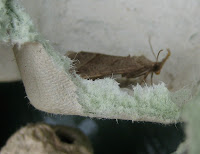
Happiness! I had hoped that something special would arrive on Olly's birthday, and look at this. It's a Large Emerald, the biggest and greenest of Britain's green moths. Anyone who dips in regularly will know my weakness for green, so you can imagine my joy,

 specially as I had missed it at first when I gazed at the multitude of yellow underwings in my solitary eggbox and the scrunched up newspapers which I am using while Penny and I eat as many eggs as we can stand, to restock. I went back a couple of hours later to sort out the trap, because it had rained and things were a bit damp. There was the moth, patiently waiting on the outside of the trap's black plastic bowl. Waring, Townsend & Lewington (my moth Bible) say that the species has a habit of coming to light but not entering the trap. How right they are, once again.
specially as I had missed it at first when I gazed at the multitude of yellow underwings in my solitary eggbox and the scrunched up newspapers which I am using while Penny and I eat as many eggs as we can stand, to restock. I went back a couple of hours later to sort out the trap, because it had rained and things were a bit damp. There was the moth, patiently waiting on the outside of the trap's black plastic bowl. Waring, Townsend & Lewington (my moth Bible) say that the species has a habit of coming to light but not entering the trap. How right they are, once again.The moth was a very co-operative photographic model, and I eventually hid it deep in a creeper, as it had started raining again. Indeed at midday we had hail. Now the sun is out again, although this isn't particularly good news for green moths. Their colour fades faster in the light than any other in the spectrum, although the Large Emerald is known, and admired, for staying greener longer than any of the others.















































